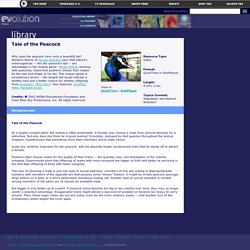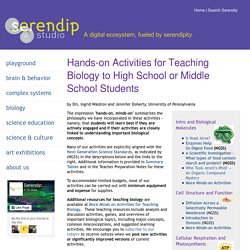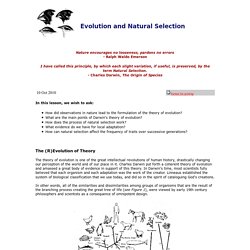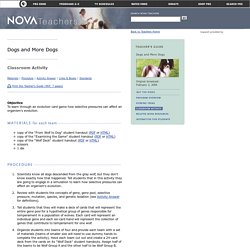

Stop the Spread of Superbugs - NIH News in Health, February 2014. For nearly a century, bacteria-fighting drugs known as antibiotics have helped to control and destroy many of the harmful bacteria that can make us sick.

But in recent decades, antibiotics have been losing their punch against some types of bacteria. In fact, certain bacteria are now unbeatable with today’s medicines. Sadly, the way we’ve been using antibiotics is helping to create new drug-resistant “superbugs.” Superbugs are strains of bacteria that are resistant to several types of antibiotics. Each year these drug-resistant bacteria infect more than 2 million people nationwide and kill at least 23,000, according to the U.S.
Antibiotics are among the most commonly prescribed drugs for people. Unfortunately, many antibiotics prescribed to people and to animals are unnecessary. Here’s how that might happen. Education_6_4215086518.pdf. Videos - Stated Clearly. Applied_Unit.pdf. What is the Evidence for Evolution?
What causes antibiotic resistance? - Kevin Wu. Sumanas: The Rise in Antibiotic Resistance. Teach - Evolution of life. Pepper-moths. The Making of the Fittest: Natural Selection and Adaptation. Applied_Unit.pdf. Bill Nye The Science Guy Full Episode & Evolution. eChalk Preview: Peppered moth natural selection simulation. Evolution: Library: Evolution of Camouflage. In the insect world things are often not what they seem, especially if you're a hungry predator.

For 250 million years, insects have survived because they often appear to be something other than what they really are. Is it a bug, a twig, or a leaf? Is that butterfly the bitter-tasting one, or the delicious one that resembles it? An astonishing number of insects have evolved survival mechanisms that involve mimicry, camouflage, and disguise. In the case of orange-and-black butterflies, the viceroy has evolved a striking resemblance to the beautiful but foul-tasting monarch. Sometimes the mimicry is not visual but auditory, as in some harmless flies that emit a sound just like the buzzing of an angry bee or wasp, keeping attackers away. When an insect happens to blend in with its environment, it's called camouflage. In camouflage, the shape and outline of the animal merge with the background so it's not recognizable.
Evolution: Library: Tale of the Peacock. At a singles cocktail party, the ending is often predictable.

A female may choose a male from several because he is attractive. But why does she think he is good looking? Scientists, stumped by that question throughout the animal kingdom, hypothesized that something more than chemistry drives mate choice. Looks are certainly important for the peacock, with his absurdly bright, burdensome train that he shows off to attract a female. Peahens often choose males for the quality of their trains -- the quantity, size, and distribution of the colorful eyespots. This way of choosing a mate is just one type of sexual selection: members of one sex mating in disproportionate numbers with members of the opposite sex that possess some "showy" feature. But bigger is only better up to a point. Sorting Finch Species. Recipe For Evolution: Variation, Selection, & Time.
Woodrow Wilson Collection - Evolution. Hands-on Activities for Teaching Biology to High School or Middle School Students. By Drs.

Ingrid Waldron and Jennifer Doherty, University of Pennsylvania The expression "hands-on, minds-on" summarizes the philosophy we have incorporated in these activities - namely, that students will learn best if they are actively engaged and if their activities are closely linked to understanding important biological concepts. Many of our activities are explicitly aligned with the Next Generation Science Standards, as indicated by (NGSS) in the descriptions below and the links to the right. Additional information is provided in Summary Tables and in the Teacher Preparation Notes for these activities. To accommodate limited budgets, most of our activities can be carried out with minimum equipment and expense for supplies.
Additional resources for teaching biology are available at More Minds on Activities for Teaching Biology. Read More Intro and Biological Molecules. Activities for Evolution. Evolution and Natural Selection. Nature encourages no looseness, pardons no errors - Ralph Waldo Emerson I have called this principle, by which each slight variation, if useful, is preserved, by the term Natural Selection.

The Zoo of You. By Neil Shubin Posted 10.26.09 NOVA You may not feel much like a shark, fruit fly, or worm, but you share many aspects of your anatomy and physiology with these and all other animals on Earth.

All the various bits and pieces of you–organs, bones, nerves, even your genes–show up in different but fundamentally similar forms in other animals, in some cases animals that lived half a billion years ago, revealing how all creatures on Earth, including you, are just variations on a theme. Launch Interactive. Evolution. Evolution: Online Lessons for Students: Activity 1- Activity Title. Evolution: Isn't Evolution Just a Theory? Evolution: Library: The Red Queen. Chuckabees.pdf. Evolution: Videos for Students: Evolving Ideas. Who Evolved on First? Bud Abbott and Lou Costello While I was writing this post, I heard that Bill Nye and Ken Ham are planning to have a debate about evolution and creation.

While it could be an interesting conversation, I suspect that it will suffer from the same communication problems that afflict most of these debates. Have you ever heard the brilliant comedy routine, “Who’s on first?” By Bud Abbott and Lou Costello? If not, you should listen to it before you continue reading. BBC Nature - Adaptations and behaviours. Charles Darwin's Game of Survival. Evolution Lab. Classroom Activity. Objective To learn through an evolution card game how selective pressures can affect an organism's evolution. copy of the "From Wolf to Dog" student handout (PDF or HTML)copy of the "Examining the Game" student handout (PDF or HTML)copy of the "Wolf Deck" student handout (PDF or HTML)scissors1 die Scientists know all dogs descended from the gray wolf, but they don't know exactly how that happened.

Tell students that in this activity they are going to engage in a simulation to learn how selective pressures can affect an organism's evolution.